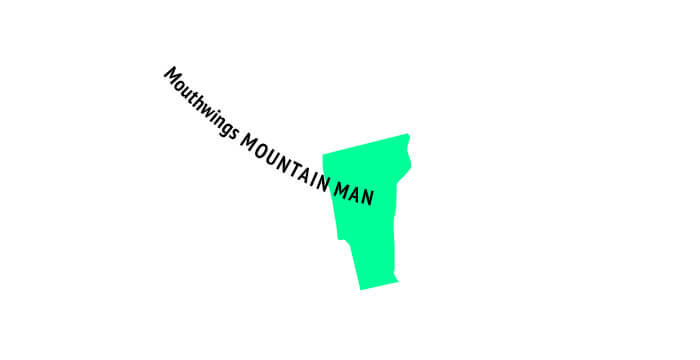Musical Map Of The USA: Vermont—Mountain Man


I lived in Vermont for three years when I was a college student, from 2006 to 2009, and even then, just barely—Bennington is in the state’s southwestern corner, north of Massachusetts and east of New York. Pieces of its landscape still pop up in my dreams once in a while, especially the low-slung mountains that overlooked the field in front of the music building, the way they would light up in shades of purple and red as the sun goes down. You can see most of the campus from the highway a couple of miles south, looking something like a vacant church retreat or an off-season summer camp.
There is a brick building with six chimneys and a raised, plantation-style porch looking out onto a large lawn, bookended by two rows of white colonial houses. On campus you can peer back at the highway from that lawn at a point referred to by students as “the end of the world,” because of the way the ground drops off sharply and vanishes behind a fence of piled stone. There is a palpable barrier between the college and its surroundings, and several months into any given semester I remember feeling my awareness of an outer world starting to drift away entirely, only for it to rush back as soon as classes had ended.
Isolation, not from each other but from the world at large, was Bennington’s defining force. If it got to be too much, you could walk through the woods to North Bennington to pick up beer or cigarettes at Powers or to eat dinner at one of a couple restaurants, but the atmosphere of the school wouldn’t really begin to let up until you got further off campus, onto Main Street in the town of Bennington or, if you had a car, into Hoosick or Williamstown.
But soon enough, you would be back in Vermont, and it would be night, and the night sky would be one of the clearest you had ever seen, full of clouds that turned out to be galaxies. And if it were Friday or Saturday, you would know which of the houses on campus were having a party that night, and which bands were playing in this living room or that event space. And you would know everyone’s gossip, because this was a school of seven hundred, just a collection of houses and classrooms on a hill in rural New England, and the drama of these few hundred people’s lives weaving in and out of one another was inescapable.
Many people thrived in this atmosphere, and many couldn’t stand it and left as soon as they realized that the social intensity was to be a constant of on-campus life. Some people went a bit crazy but managed to stick it out for four years. I transferred in as a sophomore, and I wish that I had been there as a freshman, too, but I know that it wouldn’t change the way that I remember it, a flurry of conflicting memories. The pressure we all felt was ultimately not to be cool, but to come to an understanding about who we were in relation to every other misfit around us, each in a different stage of arrogance or fragility, and to negotiate some sort of truce before it was our turn to leave. Our academic work was as much a part of this self-examination as our social lives, and there was no real division between the two. Most of my friends were artists of one kind or another, and the most crucial resource we had was a permanent and captive audience for our work.
Mountain Man was one of dozens of bands that formed at the college while I was there, playing in hallways and living rooms and in the communally-run houses off campus in North Bennington; three women, singing unaccompanied with a forceful, striking clarity or, on some songs, with one member playing guitar to anchor their trapeze-like harmonies. I didn’t see their first performance, but I saw maybe their second, playing to about 30 people in a stairwell in Commons, up on the then-abandoned third floor. I remember it being very humid even though I think it was winter or early spring. Their three voices clashed and weaved by turns in the close air, blurring at times into metallic overtones due to the odd angles of the space. The audience was silent except for the rustling of their clothes and their breathing.
The influences that I thought I could pick out at the time are meaningless, because the music’s presence was more striking than evocative, and because the music that I heard in their music was simply in the air at the time at school–sacred harp, Appalachian folk, R&B, piedmont blues, plainchant, and all of the tensile experimental music that filtered through on tour in between shows in Bushwick and Jamaica Plain. What set Mountain Man apart was how any influence they had digested had been so fully transformed in the process. Their music was not a pastiche, it was just theirs, and by default, ours.
You could spend a long time trying to hash out the contributions of Mountain Man’s different members in order to flesh out a map of three distinct artistic identities. It seemed like Alex’s songs were largely about humans in relation to nature, and about the slow passage of time, and the melodies were intuitive, sung in a comfortable range. Molly’s songs were rawer, structured with a surety and fatalism that made them feel stark, almost primitive.
Amelia’s songs were theatrical and ebullient, vaudevillian as much as from a folk tradition, but somehow they maintained the gravity of the others. In the end, this analysis is completely facile: collaboration brings things out in our own work that may not come from us at all. But what I saw that first time, and what I continued to see every time I saw Mountain Man, was a transparent mode of performance at odds with nearly every band I’d ever seen, and I still think about it and wonder if I’ll ever see anything like it again.
“Mouthwings,” one of Amelia’s compositions, is the song that stays with me the most. I remember that they sang it that first time I saw them sing in the stairwell, and that the performance was nearly identical to the one that would later appear on Made The Harbor, though maybe I’m wrong–it could have been later that year. It explores themes that Amelia would go on to write about in finer detail in Sylvan Esso: womanhood, motherhood, intimacy, and for lack of a better word, fate, all cryptically entwined, but all secondary to the vocal acrobatics on display.
Even more than in “Sewee Sewee” or “River,” “Mouthwings” is hard to pin down structurally or stylistically. Its passing dissonances feel sacred, recalling the liturgy of Hildegard Von Bingen or the medievalism of 70’s folk culture as much as anything from our century. Timelessness is a funny thing, in that it is as fleeting and ever-changing as datedness, but of any of the music that I saw firsthand in school or in the years that immediately followed in Brooklyn, “Mouthwings” (and much of the rest of Mountain Man’s repertoire) feels timeless.
The best performance of “Mouthwings” that I heard wasn’t in person and it wasn’t on record: it was from a Yours Truly performance online. You can see it yourself on Youtube. Even now, watching it brings back the feeling of being in that stairwell, seeing Mountain Man for the first time in 2008. It wasn’t the vulnerability with which they performed, or the simultaneous (and contagious) pride that they happily displayed, or the solemnity that crossed over their faces when the music demanded it, or the silence that they commanded. It was the oxygen in the room that we were all breathing, and the way the music drew attention to this unspoken simultaneity, music becoming breath, becoming music.
[sc name=”nattysaw9″ ]
You might also like 




















